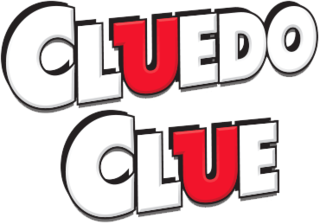
Cluedo, known as Clue in North America, is a murder mystery game for three to six players that was devised in 1943 by British board game designer Anthony E. Pratt. The game was first manufactured by Waddingtons in the United Kingdom in 1949. Since then, it has been relaunched and updated several times, and it is currently owned and published by the American game and toy company Hasbro.

Sorry! is a board game that is based on the ancient Indian cross and circle game Pachisi. Players move their three or four pieces around the board, attempting to get all of their pieces "home" before any other player. Originally manufactured by W.H. Storey & Co in England and now by Hasbro, Sorry! is marketed for two to four players, ages 6 and up. The game title comes from the many ways in which a player can negate the progress of another, while issuing an apologetic "Sorry!"

Where on Earth Is Carmen Sandiego? is an American live action/animated television series based on the series of computer games. The show was produced by DIC Productions L.P. and originally aired from 1994 to 1999, on Saturday mornings during FOX's Fox Kids Network block. Reruns aired on the Qubo television network from June 9, 2012 to May 26, 2018.
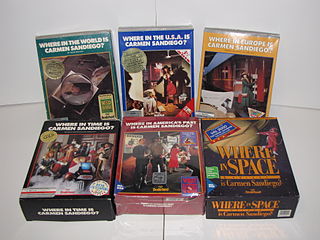
Carmen Sandiego is a series of American educational mystery video games that spawned an edutainment franchise of the same name. The game released in 1985, Where in the World Is Carmen Sandiego?, started off both the video game series and the franchise as a whole, which has continued up to the present day. Each game of the series has a particular theme and subject, where the player must use their knowledge to find Carmen Sandiego or any of her innumerable henchmen. This series was originally owned by Broderbund, but is now owned by Houghton Mifflin Harcourt. Since its initial release the series has won over 125 awards and accolades.
In tabletop games and video games, game mechanics are the rules or ludemes that govern and guide the player's actions, as well as the game's response to them. A rule is an instruction on how to play, a ludeme is an element of play like the L-shaped move of the knight in chess. A game's mechanics thus effectively specify how the game will work for the people who play it.
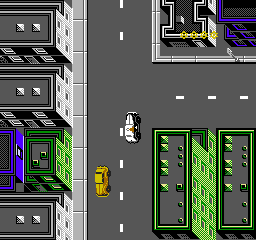
Dick Tracy appeared in the following video game tie-ins for the motion picture:
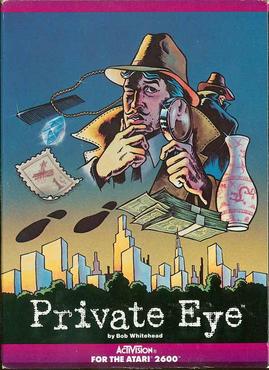
Private Eye is an action video game developed and published by Activision and released in 1983 for the Atari 2600 video game system. Designed by Bob Whitehead, who also wrote Chopper Command, Private Eye requires players to track down clues and recover items stolen by a master criminal, ultimately leading to his capture and arrest.
Clue The Musical is a musical with a book by Peter DePietro, music by Galen Blum, Wayne Barker and Vinnie Martucci, and lyrics by Tom Chiodo, based on the board game Clue. The plot concerns a murder at a mansion, occupied by several suspects, that is solved by a detective, while the ending is decided by the audience.
Sherlock Holmes: Consulting Detective is a game originally published by Sleuth Publications in 1981. Multiple expansions and reprints of the game have since been released.

Clue: Parker Brothers' Classic Detective Game is a North American-exclusive video game published for the Super Nintendo Entertainment System and Sega Genesis video game consoles. It is based on the popular board game of the same name.
True Crime is a series of open world action-adventure video games told from the perspective of law enforcement. There are two games in the series, True Crime: Streets of LA, released in 2003, and True Crime: New York City, released in 2005. Each game features GPS-accurate open world recreations of parts of Los Angeles and New York City, respectively. Streets of LA was developed by Luxoflux for the PlayStation 2, Xbox and GameCube, and ported to Microsoft Windows by LTI Gray Matter, to mobile by MFORMA and to macOS by Aspyr. It was published on all systems by Activision, except the Mac version, which was published by Aspyr. New York City was developed by Luxoflux for PlayStation 2, Xbox and GameCube, and ported to Windows by Aspyr and to mobile by Hands-On Mobile. It was published on all systems by Activision.

Mystery Mansion is the name of a series of board games in which players search furniture and other objects inside a mansion to locate a hidden treasure or stash of money.
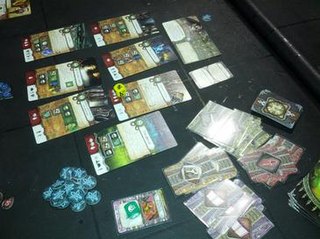
Elder Sign is a cooperative card and dice game, based on the Cthulhu Mythos of horror writer H.P. Lovecraft and Chaosium's Call of Cthulhu roleplaying game. It is published by Fantasy Flight Games, which also produces the Cthulhu Mythos games Arkham Horror, Call of Cthulhu: The Card Game, Mansions of Madness, and Eldritch Horror.

Where in Time Is Carmen Sandiego? is a multiplatform video game where players have to travel through time to collect clues and the warrants necessary to capture Carmen Sandiego or her henchmen. The goal of this game is to track Carmen's villains through history and arrest them and ultimately arrest Carmen herself.

Carmen Sandiego: Junior Detective is a 1995 education game in the Carmen Sandiego franchise developed by Broderbund. Although not a version of Where in the World Is Carmen Sandiego? by name, it is essentially a simplified version of it for pre-readers. Allgame says the game "is geared for younger users, with only 14 cases to solve". The lead characters of the FOX animated series Where on Earth Is Carmen Sandiego?, Zack and Ivy, were included in the game, along with Stretch - "ACME's crime-tracking dog".

Where in Europe Is Carmen Sandiego? is a 1988 European geography-based educational computer game in the Carmen Sandiego detective mystery franchise. It was originally published by Broderbund in 1988 for Apple II, Commodore 64, and DOS, and ported to the Amiga and Macintosh in 1989. It is the third Carmen Sandiego title, after Where in the World Is Carmen Sandiego? (1985) and Where in the USA Is Carmen Sandiego? (1986). Under the guidance of The Acme Agency's chief, the player completes cases to catch Carmen's henchmen; they accomplish this by traveling to European cities to find clues relating to the crook's last known whereabouts, and by gaining enough character data to issue a warrant of arrest. Once the player has captured all 15 thieves, they can pursue Carmen herself.
The Genius: Rule Breaker is the second season of The Genius, which debuted on tvN on December 7, 2013.
Cluedo, known as Clue in North America, is a murder mystery-themed multimedia franchise started in 1949 with the manufacture of the Cluedo board game. The franchise has since expanded to film, television game shows, book series, computer games, board game spinoffs, a comic, a play, a musical, jigsaws, card games, and other media.
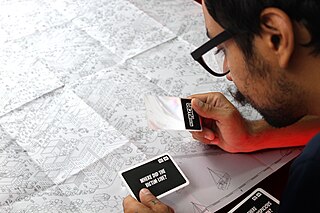
MicroMacro: Crime City is a cooperative tabletop crime-solving hidden object game designed by Johannes Sich and published in 2020 by Edition Spielwiese. The game received positive reviews and won the Spiel des Jahres in 2021. A sequel to the game, MicroMacro: Crime City – Full House was released in August 2021.













